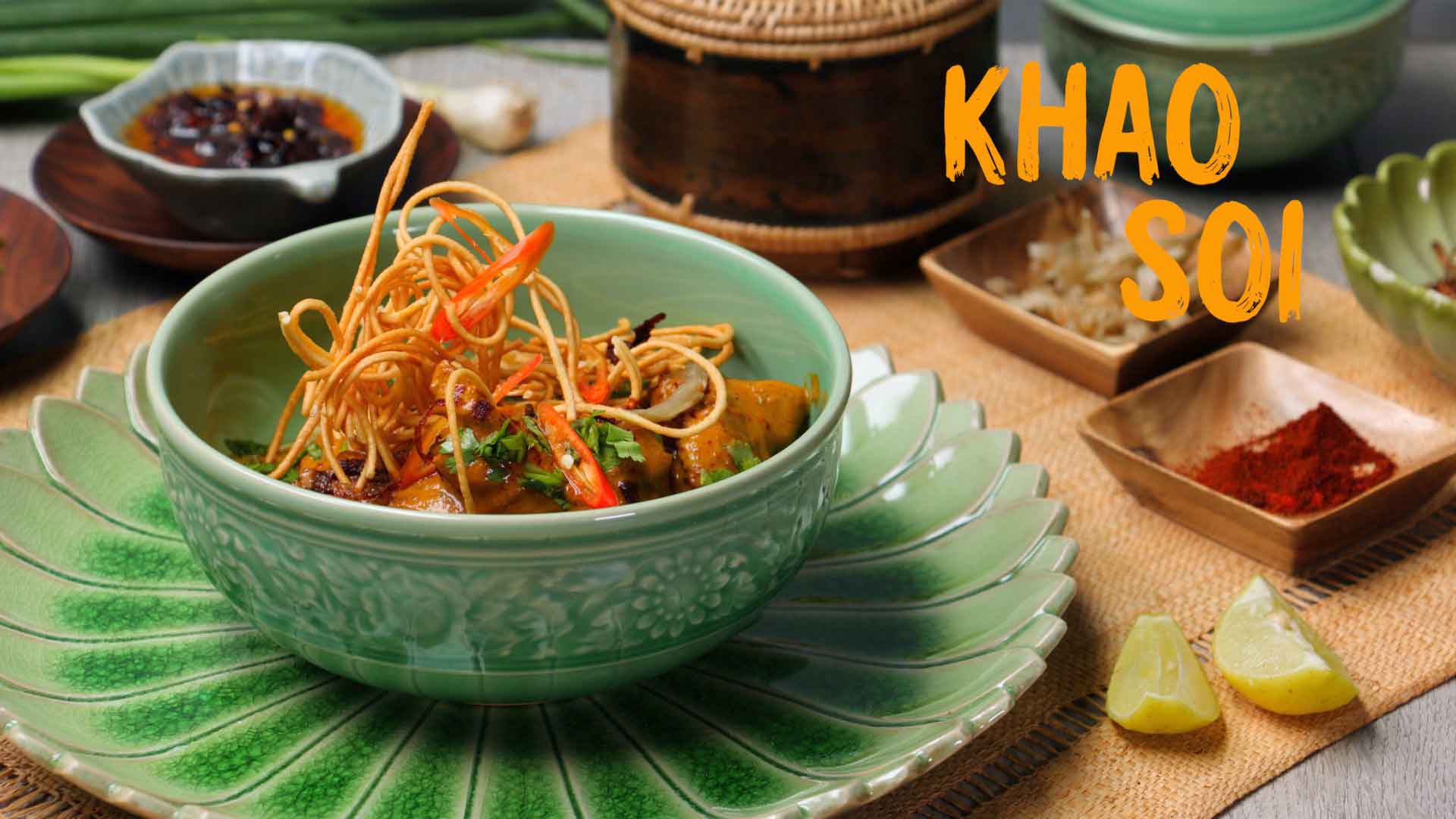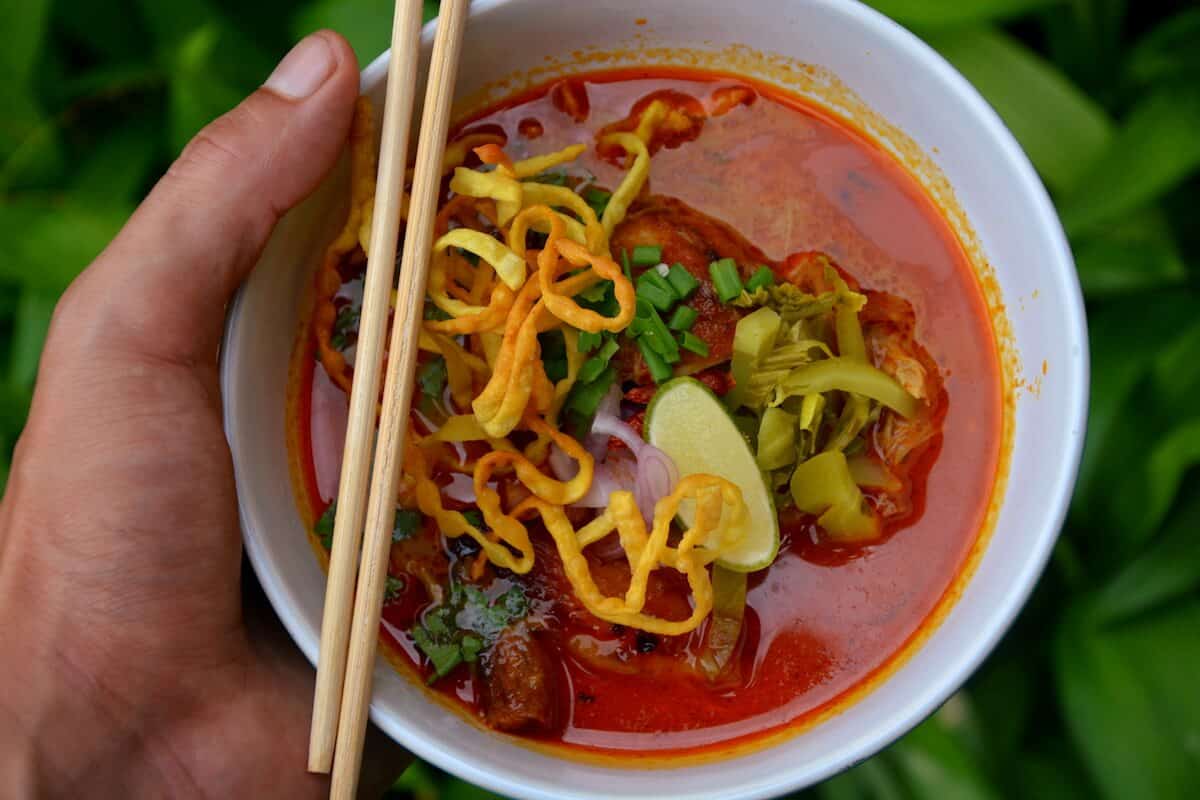Embark on a culinary adventure as we delve into the world of Khao Soi, a beloved noodle dish that has captured the hearts of food enthusiasts around the globe. Originating in northern Thailand, Khao Soi tantalizes the taste buds with its symphony of flavors, textures, and colors.
Join us as we explore the secrets behind this delectable dish, from its humble beginnings to its present-day popularity.
In this comprehensive guide, we will unravel the intricate ingredients, step-by-step instructions, and fascinating history of Khao Soi. Whether you are a seasoned chef or a culinary novice, this guide will empower you to recreate this culinary masterpiece in your own kitchen, bringing the vibrant flavors of Thailand to your table.
Ingredients

Authentic Khao Soi, a Northern Thai culinary delight, is a symphony of flavors that relies on a carefully curated blend of fresh and flavorful ingredients.
The foundation of this dish lies in its rich and aromatic curry paste, a complex concoction of dried chilies, lemongrass, galangal, turmeric, cumin, and coriander. This paste imparts a vibrant red hue and a symphony of spicy, earthy, and citrusy notes.
Noodles
- Egg Noodles: Flat, wide egg noodles form the base of Khao Soi, providing a chewy and satisfying texture.
Curry Paste
- Dried Chilies: These provide the dish’s signature heat, ranging from mild to fiery, depending on the variety used.
- Lemongrass: This aromatic herb adds a citrusy freshness and subtle sweetness.
- Galangal: A relative of ginger, galangal imparts a unique earthy and peppery flavor.
- Turmeric: This vibrant yellow spice adds a warm, slightly bitter note and gives the curry its characteristic golden hue.
- Cumin: This earthy spice provides a warm and slightly nutty flavor.
- Coriander: The seeds of this herb add a citrusy and slightly floral aroma.
Coconut Milk
Coconut milk forms the creamy base of Khao Soi, adding richness and a hint of sweetness. It balances the spicy heat of the curry paste and creates a velvety texture.
Vegetables
- Shallots: These add a subtle sweetness and a delicate crunch.
- Red Onions: Their pungent flavor complements the spicy curry paste.
- Green Onions: These provide a fresh and vibrant touch.
- Cabbages: Napa or bok choy cabbage adds a crunchy texture and a slightly bitter flavor.
- Mushrooms: Shiitake or oyster mushrooms add an earthy and umami-rich flavor.
Garnishes
- Crispy Fried Noodles: These add a contrasting texture and a nutty flavor.
- Lime Wedges: Their acidic juice brightens the flavors and cuts through the richness.
- Coriander Leaves: These fresh herbs provide a burst of citrusy aroma.
- Red Chili Flakes: For those who crave an extra kick of heat.
Step-by-Step s
To embark on the culinary journey of crafting an authentic Khao Soi, let’s break down the process into a series of well-defined steps. Each step will provide detailed guidance, ensuring that even culinary novices can confidently navigate the path to success.
Our meticulous approach will cover every aspect of preparation, from the initial stages to the final assembly. We’ll delve into the techniques and timing involved, empowering you with the knowledge to execute each step with precision and finesse.
Curry Paste Preparation
The foundation of Khao Soi lies in its flavorful curry paste. In this step, we’ll embark on a sensory adventure as we combine a symphony of spices, herbs, and aromatics. The precise measurement and blending of these ingredients will create a harmonious base for our culinary masterpiece.
- Gather the necessary spices: coriander seeds, cumin seeds, red chili peppers, lemongrass, galangal, garlic, shallots, and kaffir lime leaves.
- Toast the coriander and cumin seeds in a dry skillet over medium heat until fragrant.
- Combine all the ingredients in a mortar and pestle or food processor and grind until a smooth paste forms.
Variations and Adaptations
Khao Soi’s versatility shines through its regional variations across Thailand. In the northern city of Chiang Mai, the dish boasts a rich, creamy broth flavored with a complex blend of spices and coconut milk. Moving south to Bangkok, the broth becomes thinner and more sour, while the noodles are often crispier.
In the northeastern province of Isan, Khao Soi takes on a spicy and savory character, with the addition of fermented pork sausage.
Creative Adaptations
Beyond regional variations, Khao Soi has inspired a myriad of creative adaptations. Vegetarian and vegan versions swap out the meat for tofu, tempeh, or vegetables, while fusion interpretations incorporate elements from other cuisines. For instance, some chefs have experimented with using green curry paste or even roasted red peppers in their Khao Soi.
Presentation and Serving
Traditionally, Khao Soi is served in vibrant bowls, showcasing the colorful layers of the dish. The noodles form the base, topped with the rich and flavorful broth, and adorned with an array of garnishes.
To enhance the visual appeal of your Khao Soi, consider using contrasting colors in the garnishes. For example, vibrant green scallions, crisp red onions, and fresh cilantro leaves add a pop of color and freshness. The deep orange of pickled mustard greens or the golden crunch of fried shallots provide a striking contrast to the rich broth.
Accompaniments and Condiments
Khao Soi is often accompanied by a variety of condiments and accompaniments to complement its complex flavors. These include:
- Lime wedges: A squeeze of fresh lime juice adds a refreshing acidity that balances the richness of the dish.
- Pickled chili peppers: These provide a spicy kick and enhance the umami of the broth.
- Crispy shallots: Fried shallots add a savory and crunchy texture, contrasting with the soft noodles.
- Bean sprouts: Fresh or blanched bean sprouts add a crisp and refreshing element to the dish.
- Fresh herbs: Cilantro, scallions, and mint are commonly used to garnish Khao Soi, providing a burst of freshness and aromatic notes.
History and Cultural Significance
Khao Soi’s origins trace back to the late 19th century, when Muslim Chinese traders from Yunnan, China, settled in Northern Thailand.
They brought with them their culinary traditions, which blended with local Thai flavors to create this unique dish. Khao Soi became a staple in the Lanna region of Northern Thailand and gradually spread to other parts of the country.
Role in Thai Cuisine and Society
Khao Soi holds a significant place in Thai cuisine, particularly in Northern Thailand, where it is considered a beloved dish. It is commonly served at festivals, celebrations, and as a comforting meal in daily life.
Its rich flavors and the combination of textures make it a favorite among both locals and visitors.
Summary

As we conclude our culinary journey, we cannot overstate the significance of Khao Soi in Thai cuisine. It is a dish that embodies the country’s rich culinary heritage, blending traditional flavors with modern influences. From street food stalls to Michelin-starred restaurants, Khao Soi continues to captivate diners with its unique and unforgettable taste.
Whether you savor it as a hearty meal or a celebratory dish, Khao Soi is sure to leave a lasting impression on your palate and your heart.
FAQ Summary
What is the origin of Khao Soi?
Khao Soi originated in northern Thailand, likely influenced by neighboring countries such as Burma and China.
What are the key ingredients in Khao Soi?
The essential ingredients include egg noodles, a flavorful curry paste, coconut milk, vegetables (such as cabbage and shallots), and a variety of garnishes.
What is the difference between Khao Soi and other Thai noodle dishes?
Khao Soi is unique in its use of crispy egg noodles, a rich and creamy curry broth, and a combination of pickled and fresh vegetables.
How can I adapt the Khao Soi recipe to my dietary preferences?
Khao Soi can be easily adapted to vegetarian, vegan, or gluten-free diets by substituting ingredients accordingly.
